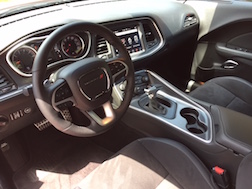The nickname has been around for ages, but I still snicker whenever I hear the term “muscle car.” I always imagine some ripped young dude in sunglasses, cruising around with the window rolled down, his bicep pressed against the door, the other hand lightly placed at 12 o’clock, maneuvering a twisty road near the beach. Probably AC/DC jumping out of the speakers, right?
 Then I drive through Arvada or Centennial and see a member of AARP walking out of a 7-11 with a Big Gulp and a fruit pie, getting behind the wheel of a Mustang or Challenger and setting off for the world of stop-n-go traffic with his favorite Katy Perry song to keep him company.
Then I drive through Arvada or Centennial and see a member of AARP walking out of a 7-11 with a Big Gulp and a fruit pie, getting behind the wheel of a Mustang or Challenger and setting off for the world of stop-n-go traffic with his favorite Katy Perry song to keep him company.
Okay, so muscle cars aren’t for any specific demographic. Younger, older, it doesn’t matter. And the Dodge Challenger has made a statement by rolling up its sleeves and flexing.
The Basics
Since the Viper story came to a close last year (at least temporarily), that leaves the Charger and the Challenger as the only coupes bearing the Dodge name.
I spent a week with the ’18 Challenger GT, one of a bazillion trim/sub-trim levels you can choose from. The first thing I noticed when I eased out of the parking garage was: Dang, this car is large. Don’t know yet if it’s in charge, but it’s large.
This particular iteration comes with a 3.6-liter V6, which puts out a little over 300 horsepower. But it seems like a law (at least in the automotive journalism world) that you MUST mention the fact that you can opt for the monster versions of the Challenger, the Hellcat and the Demon.
Personally, I don’t need 700-800 horsepower (which those bad boys generate) to drive 35 mph down Colorado Blvd. The GT is just fine. Of course, I’m not trying to impress all the guys at The Piper Inn. (Well, maybe a little.)
One thing to keep in mind before you get in – and for sure before you get out – is the size of the doors. Since it’s a big car, the doors aren’t the best if you park in a cramped lot. I actually made old-man sounds a couple of times as I squeezed in and out.
The Drive
The weight of the Challenger – about two tons – certainly affects the drive. The power plant is enough to satisfy your get-up-and-go tendencies in a sports car, but the size does need to be kept in mind.
I found myself questioning the space around the car when I had to make tight turns, and you’d think the bulk would translate into a rough drive.
But it didn’t. Not Lexus-smooth by any stretch, but the ride was pretty good. Acceleration is decent, if not up to the specs of its competitors. Steering is responsive, and the grip of the tires handled turns quite well.
The Inside
 Dodge likes to brag about the roominess of the Challenger, and, compared to the Mustang or Camaro, yeah, it’s good. Nobody’s doing calisthenics in there, mind you, but at least the Challenger boasts a back seat that can (at least according to the Dodge media folks) accommodate five butts.
Dodge likes to brag about the roominess of the Challenger, and, compared to the Mustang or Camaro, yeah, it’s good. Nobody’s doing calisthenics in there, mind you, but at least the Challenger boasts a back seat that can (at least according to the Dodge media folks) accommodate five butts.
Personally, I didn’t feel that way. To me the back seat is utilitarian, and great for hauling stuff.
But the front cockpit is quite good when it comes to space. I liked the personal storage, including a center bin that can hold all the stuff you like up there.
The angled shifter is a nice touch, and the display screen does only as much as it should. The other controls, using knobs and buttons – yay! – provide easy manipulation of the most important things.
Kudos to the Dodge engineers for not over-teching (if that wasn’t a word before, it is now). And speaking of tech . . .
The Tech
Dodge doesn’t want to make you pay super-big bucks for their Challenger, so they haven’t made it a Bond car.
Having said that, I like what they bring to the table – er, to the dashboard.
The recently-revamped Uconnect system offers the sophisticated lifestyle we’ve become spoiled to with our devices. Things such as virtually locking and unlocking your car, remote start, and vehicle assistance are part of that package.
And, on a lower-tech note, I can say that I enjoyed the sound system. Granted, it was a Harman Kardon upgrade option, but still. And all without a single AC/DC or Katy Perry tune.
The Bottom Line
The muscle car segment isn’t as crowded as it used to be, and these days it’s pretty much Mustang versus Camaro versus Challenger.
Dodge has put its chips on the heavyweight of the group, and it’s playing out well. The only real negatives I noted during my week behind the wheel included nasty blind-spot issues – but that’s not uncommon with this kind of car.
On the flip side, the backup camera and blind-spot monitoring toys help out.
The beefier models (the aforementioned Hellcat and Demon) will run you more, obviously, but the GT I drove came in at just under $38k, including some options.
No, it’s not marketed as a family car, but if you’re looking for a truly stylish ride, the Challenger is fun. Be sure to hit some twisty mountain roads on your test drive, and you’ll see what I mean.
The Details
2018 Dodge Challenger GT
3.6-liter V6, with 8-speed automatic transmission
Gas mileage: 18/27/21 combined
MSRP: $33,495
As tested: $37,670
Reviewed by Dom Testa
Vehicle provided by manufacturer






